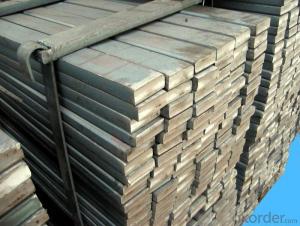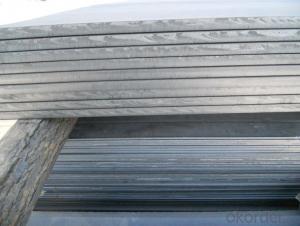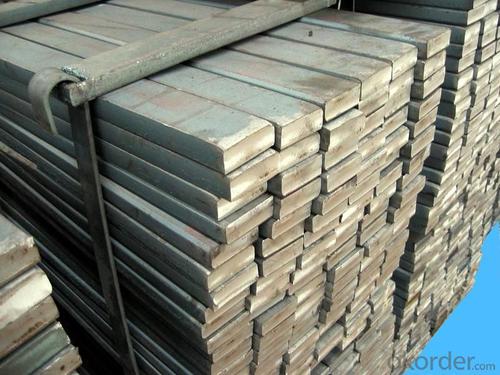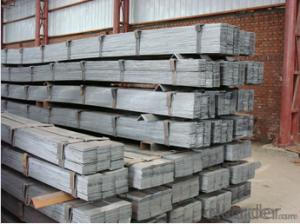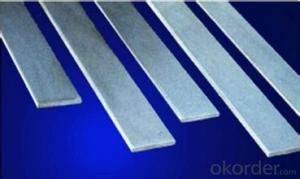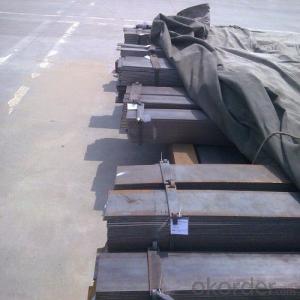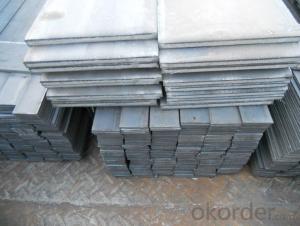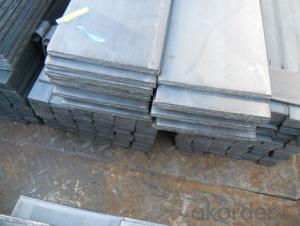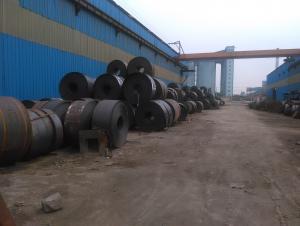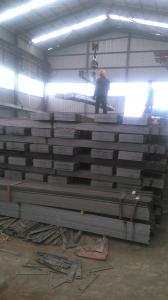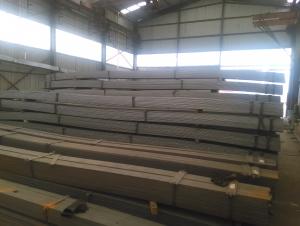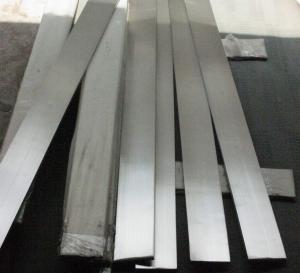Hot Rolled Flat Bar with Material Grade Q235B
- Loading Port:
- Tianjin
- Payment Terms:
- TT OR LC
- Min Order Qty:
- 25 m.t
- Supply Capability:
- 10000 m.t/month
OKorder Service Pledge
OKorder Financial Service
You Might Also Like
Product Description:
OKorder is offering high quality Flat Bar at great prices with worldwide shipping. Our supplier is a world-class manufacturer of steel, with our products utilized the world over. OKorder annually supplies products to European, North American and Asian markets. We provide quotations within 24 hours of receiving an inquiry and guarantee competitive prices.
Product Applications:
Flat Bars are ideal for structural applications and are widely used in the construction of buildings and bridges, and the manufacturing, petrochemical, and transportation industries.
Product Advantages:
OKorder's Flats Barare durable, strong, and resist corrosion.
Main Product Features:
· Premium quality
· Prompt delivery & seaworthy packing (30 days after receiving deposit)
· Corrosion resistance
· Can be recycled and reused
· Mill test certification
· Professional Service
· Competitive pricing
Product Specifications:
Manufacture: Hot Rolled
Grade: Q195 – 235
Certificates: ISO, SGS, BV, CIQ
Length: 6m – 12m, as per customer request
Packaging: Export packing, nude packing, bundled
Chemical composition of Q235
Alloy No | Grade | Element(%) | ||||
C
| Mn
| S
| P
| Si
| ||
Q235
|
B
|
0.12—0.20 |
0.3—0.7 |
≤0.045 |
≤0.045
|
≤0.3
|
Physical properties of Q235
Alloy No | Grade | Yielding strength point(Mpa) | Tensile strength (Mpa) | Elongation after fracture(%) | ||||||
Thickness (mm) | Thickness (mm) | |||||||||
≤16 | >16--40 | >40--60 | >60--100 | ≤16 | >16--40 | >40--60 | >60--100 | |||
≥ | ≥ | |||||||||
Q235 |
B |
235 |
225 |
215 |
205 |
375--500 |
26 |
25 |
24 |
23 |
FAQ:
Q1: Why buy Materials & Equipment from OKorder.com?
A1: All products offered byOKorder.com are carefully selected from China's most reliable manufacturing enterprises. Through its ISO certifications, OKorder.com adheres to the highest standards and a commitment to supply chain safety and customer satisfaction.
Q2: How do we guarantee the quality of our products?
A2: We have established an advanced quality management system which conducts strict quality tests at every step, from raw materials to the final product. At the same time, we provide extensive follow-up service assurances as required.
Q3: How soon can we receive the product after purchase?
A3: Within three days of placing an order, we will begin production. The specific shipping date is dependent upon international and government factors, but is typically 7 to 10 workdays.
Images:
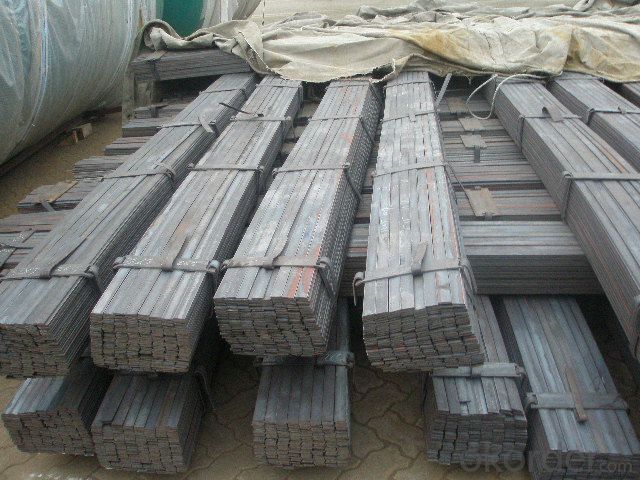
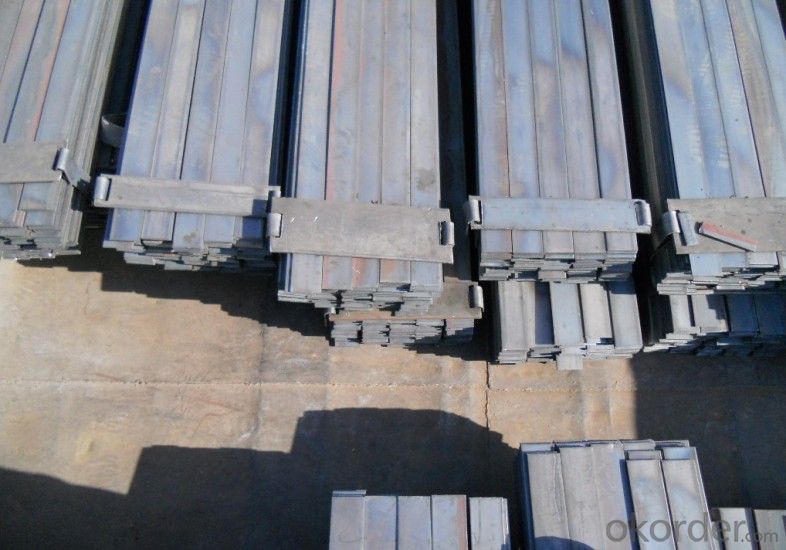
- Q: Can steel flat bars be used in food processing industries?
- No, steel flat bars are not typically used in food processing industries as they can corrode over time and contaminate the food. Stainless steel is the preferred material due to its corrosion resistance and hygienic properties.
- Q: What are the common welding methods used for steel flat bars?
- The common welding methods used for steel flat bars are MIG (Metal Inert Gas) welding, TIG (Tungsten Inert Gas) welding, and stick welding (Shielded Metal Arc Welding).
- Q: What are the different standards or specifications for steel flat bars?
- There are several different standards or specifications for steel flat bars, including ASTM A36, ASTM A108, ASTM A529, and ASTM A572. These standards provide guidelines for the chemical composition, mechanical properties, and dimensions of steel flat bars, ensuring their quality and suitability for various applications. Other organizations, such as the British Standards Institution (BSI) and the International Organization for Standardization (ISO), also have their own standards for steel flat bars.
- Q: Can steel flat bars be used for making construction equipment or vehicles?
- Yes, steel flat bars can be used for making construction equipment or vehicles. Steel flat bars are commonly used in the manufacturing of heavy-duty machinery and vehicles due to their high strength, durability, and resistance to wear and tear. They provide structural support and can be shaped or welded to meet specific design requirements.
- Q: What is the maximum length-to-width ratio for steel flat bars?
- The maximum length-to-width ratio for steel flat bars is typically around 10:1.
- Q: Can steel flat bars be used for machinery or equipment?
- Yes, steel flat bars can be used for machinery or equipment. Steel is a versatile and durable material that is widely used in various industries, including manufacturing and construction. Steel flat bars are commonly used in the construction of machinery and equipment due to their strength, rigidity, and resistance to deformation. They can be shaped, welded, and machined to fit specific requirements, making them suitable for a wide range of applications. Additionally, steel flat bars can withstand heavy loads, making them ideal for supporting and reinforcing machinery and equipment.
- Q: Can steel flat bars be used in the construction of bridges?
- Yes, steel flat bars can be used in the construction of bridges. Steel is widely used in bridge construction due to its high strength, durability, and ability to withstand heavy loads. Steel flat bars are commonly used as structural members in bridge construction, especially for beams, girders, and piers. They provide excellent support and stability, allowing bridges to span long distances and carry heavy traffic loads. Additionally, steel flat bars can be customized and fabricated to specific sizes and shapes, making them versatile and suitable for various bridge designs. Overall, steel flat bars are an essential component in bridge construction, contributing to the strength, safety, and longevity of the structures.
- Q: How do steel flat bars contribute to the overall sustainability of residential projects?
- Steel flat bars contribute to the overall sustainability of residential projects in several ways. Firstly, steel is an incredibly durable and long-lasting material. Steel flat bars are resistant to corrosion, weathering, and pests, meaning they require minimal maintenance over their lifespan. This durability ensures that residential structures built with steel flat bars have a longer lifespan, reducing the need for frequent repairs and replacements, thereby reducing waste and conserving resources. Additionally, steel is one of the most recycled materials in the world. Steel flat bars can be easily recycled at the end of their life, reducing the demand for new steel production and the associated environmental impacts. This recycling process requires less energy and emits fewer greenhouse gases compared to the production of virgin steel. By incorporating steel flat bars into residential projects, we contribute to the circular economy by promoting the reuse and recycling of materials. Furthermore, steel flat bars offer strength and versatility in construction. Their high strength-to-weight ratio allows for lighter structural elements, reducing the overall weight of the building and the amount of material needed. This not only minimizes the environmental impact during the construction phase but also reduces the load on the foundation, resulting in potential energy savings over the building's lifespan. Steel flat bars also contribute to the sustainability of residential projects by providing design flexibility. Their availability in various sizes, shapes, and finishes allows architects and engineers to create innovative and efficient designs. This flexibility enables the optimization of material usage, minimizing waste and maximizing resource efficiency. Lastly, steel flat bars are fire-resistant, making them a safe choice for residential construction. This fire resistance can enhance the overall safety of the building and reduce the risk of fire-related damage or loss, ultimately minimizing the environmental impact associated with rebuilding or repair. Overall, the use of steel flat bars in residential projects promotes sustainability by providing durability, recyclability, strength, design flexibility, and fire resistance. Incorporating these sustainable features into residential construction helps reduce waste, conserve resources, and minimize the environmental footprint of the built environment.
- Q: What are the common surface treatments for steel flat bars?
- There are several common surface treatments for steel flat bars that are used to enhance their appearance, durability, and resistance to corrosion. These treatments include: 1. Hot-dip galvanizing: This process involves immersing the steel flat bars in a bath of molten zinc, which creates a protective zinc coating on the surface. Galvanizing provides excellent corrosion resistance and can extend the lifespan of the steel flat bars. 2. Powder coating: Powder coating involves applying a dry powder to the surface of the steel flat bars and then heating it to create a durable, protective finish. This treatment offers a wide range of colors and provides excellent resistance to scratching, chipping, and fading. 3. Electroplating: Electroplating is a process in which a thin layer of metal, such as zinc, nickel, or chrome, is deposited onto the surface of the steel flat bars using an electric current. This treatment improves the appearance of the bars, enhances their corrosion resistance, and can provide a decorative finish. 4. Painting: Painting is a common surface treatment for steel flat bars, where a layer of paint is applied to the surface to provide both aesthetic appeal and protection against corrosion. Various types of paints, including epoxy, polyurethane, and enamel, can be used depending on the specific application requirements. 5. Anodizing: Anodizing is mainly used for aluminum, but it can also be applied to steel flat bars. This process involves creating an oxide layer on the surface of the metal through electrolysis, which enhances corrosion resistance and provides a decorative finish. These surface treatments for steel flat bars are widely used in various industries, including construction, automotive, manufacturing, and infrastructure projects. The choice of treatment depends on the specific requirements of the application, such as desired aesthetics, durability, and corrosion resistance.
- Q: What are the weight and strength properties of steel flat bars?
- Steel flat bars have a wide range of weight and strength properties depending on the specific grade and dimensions. Generally, steel flat bars are known for their high strength-to-weight ratio, making them a popular choice in various industries. The weight of a steel flat bar can vary depending on its dimensions, such as length, width, and thickness. The strength properties of steel flat bars are determined by the grade of steel used. Common grades include mild steel, carbon steel, and alloy steel, each with different levels of strength. Additionally, the strength can be further enhanced through processes like heat treatment or cold working. Steel flat bars are known for their excellent tensile and yield strength, which allows them to withstand heavy loads and resist deformation. They are also highly durable and resistant to corrosion, making them suitable for structural applications, construction projects, and manufacturing processes. Overall, the weight and strength properties of steel flat bars can be customized to meet specific requirements, making them a versatile and reliable material for various applications.
Send your message to us
Hot Rolled Flat Bar with Material Grade Q235B
- Loading Port:
- Tianjin
- Payment Terms:
- TT OR LC
- Min Order Qty:
- 25 m.t
- Supply Capability:
- 10000 m.t/month
OKorder Service Pledge
OKorder Financial Service
Similar products
Hot products
Hot Searches
Related keywords
